Inspiration meets innovation at Brandweek, the ultimate marketing experience. Join industry luminaries, rising talent and strategic experts in Phoenix, Arizona this September 23–26 to assess challenges, develop solutions and create new pathways for growth. Register early to save.
Since the Diversity Tipping Point of 2020, the market has been flooded with funding commitments toward racial equity, pledges to hire more Black and Brown talent, and promises from brands that they will do better. According to Edelman’s recent Trust Barometer survey, consumers are more likely to use a brand or stop using a brand because of its response to calls for racial justice.
With consumers watching and voting with their wallets, the bar has been raised high for brands to show their long-term commitment to Diversity, Equity and Inclusion (DEI). But with these expectations, there are a few diversity pitfalls brands must watch out for.
What is diversity washing?
This year more than any, my social media feed has been flooded by brands celebrating Black History Month, Asian Pacific American Heritage Month and pride. And yet many of these brands are not doing the work necessary to support historically-marginalized communities with their wallets. This includes launching a supplier diversity program, partnering and funding grassroots organizations, and finally, hiring talent from historically-marginalized communities onto their teams.
This is called diversity washing: externally pushing out DEI statements and goals, rushing to stand up for social justice issues and celebrating cultural moments that matter while not doing any of the actual work needed. If your employees are surprised by what your brands are saying and doing externally, then that’s a red flag and a sign of diversity washing. Our employees are often our forgotten consumers; before rushing to make external statements, ask for their assessment on where you truly are on your DEI journey.
When it comes to making DEI progress, marketers can’t do it alone. And remember that it is not the burden of your Black and Brown employees and Employee Resource Groups to lead your DEI efforts. Ask your CEO and the executive team about their commitment to DEI in terms of resources and budget. Ensure that you have a chief diversity officer/head of DEI and a team leading these efforts to help drive accountability and impact.
What is diversity propping?
A few years into my marketing career, I was invited to a meeting for a brand I didn’t work on. I wasn’t given any details, except to attend. I walked into a large room of about 15 marketers and agency colleagues.
I scanned the room and immediately felt a pit in my stomach. It was clear why I had been invited: I was the only person of color in the room where they were discussing a beauty product targeted to women of color.
This is called diversity propping: using one individual from a historically-marginalized community as your proof point that you have covered all bases and have the right voices at the table. When brands engage in diversity propping, they are falling into the trap that one marketer, one influencer, one spokesperson represents the voice of an entire community.
The burden also falls on this one individual to be the anti-racist or anti-sexist check. Finally, this individual can feel tokenized, that they were only asked to be involved because they check a box, and not for their talents and expertise.
Next time you want to invite a colleague of color to join a project, avoid diversity propping by letting them know you value their talent and expertise, and the views they bring with their life experience. Let them know you are focusing on diversity of representation; don’t surprise them or tokenize them. And if they decline to join, respect their wishes.
As marketers, we need to remember this important insight: “nothing for us, without us.” If you are trying to serve a community with authenticity and purpose, you need as many voices from that community around the table.
What is diversity dressing?
Recently, I saw a beauty brand post a beautiful image of a dark-skinned Black woman on their Instagram feed. A close-up image zooming in on her facial features. And when I went to research their products online, they didn’t offer an inclusive range of products—no foundations, no blushes, no eyeshadows for darker skin tones.
This is called diversity dressing: showcasing, presenting and amplifying “diversity of representation” when your products or services aren’t inclusive. In this case, the beauty brand was checking the box towards their DEI efforts by showcasing a dark-skinned Black woman. And yet, their beauty products wouldn’t meet her needs.
Diversity dressing all goes beyond trying to pretend to address racial inequities. Recently, Vogue Business called out that fashion brands were including plus-size or curve models on runways and in campaigns. Yet, increased representation in campaigns and on runways hasn’t translated to inclusive sizing in stores and on racks. This is another important reminder that you have to do the work to make sure products and services are inclusive to avoid diversity dressing.
When it comes to DEI efforts, there are no shortcuts or quick fixes. Brands have to put in the work every single day. Understanding and avoiding the three pitfalls of diversity washing, propping and dressing will set you on the path to building more inclusive brands with intention and purpose.










